| Article ID | Journal | Published Year | Pages | File Type |
|---|---|---|---|---|
| 263694 | Energy and Buildings | 2012 | 8 Pages |
Computational models of heat and moisture transport are frequently used in calculating energy gains and losses in buildings. However, any model can provide reliable information only in the case that the quality of input data is adequate. This is not always true because the standard lists of thermal and hygric parameters given by the producers as well as the material databases included in the simulation tools are usually far from complete. In this paper, we present the measurements of complete sets of heat and moisture transport and storage parameters of selected thermal insulation materials in dependence on moisture content. Two common thermal insulation materials, namely hydrophobic mineral wool and expanded polystyrene, are selected as reference materials. Two types of hydrophilic mineral wool and an autoclaved-aerated-concrete thermal insulation board are the representatives of prospective materials which appeared on the market within the last couple of years. The studied material parameters include bulk density, matrix density, porosity, saturation moisture content, thermal conductivity, specific heat capacity, moisture diffusivity, water vapor diffusion coefficient, sorption isotherm, and water retention curve.
Graphical abstractMoisture diffusivity of thermal insulation materials as a function of moisture content, YM, Ytong Multipor; MW-HB, hydrophobic mineral wool; MW-HLH, hard hydrophilic mineral wool; MW-HLS, soft hydrophilic mineral wool.Figure optionsDownload full-size imageDownload as PowerPoint slideHighlights► Complete sets of heat and moisture transport and storage properties of five thermal insulation materials are presented. ► All material parameters are measured in dependence on moisture content. ► Hydrophobic mineral wool and expanded polystyrene are selected as reference materials. ► Two types of hydrophilic mineral wool suitable for interior thermal insulation systems are analyzed. ► A thermal insulation board on the basis of autoclaved aerated concrete is investigated.
